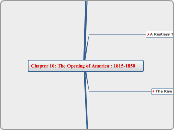Exploring Populations Ch #16
Stages in Population Change
Stage 4
The birth rate declines to the point where it is close to the death rate. This causes the population to level off. Canada is approaching this point but has not yet reached it. A few countries, particularly in Eastern Europe have reached this stage.
Stage 3
Stage 3
A drop in Birth Rate occurs. Parents limit the size of their families because they are certain that their children will survive to adulthood.
Since most families live in cities rather than on farms, they don't need large numbers of children to perform farm chores. Family size decreases and women get the opportunity to work outside the home. Canada began to experience this stage in the early 1960's. The third stage has only just begun in many very poor countries
Stage 2
Stage 2
At some point the death rates drops (especially in infants) because better healthcare and nutrition and birth rate remain high - this result in a long period of natural increase in the population.
Canada's long period of natural increase began more than 150 years ago and continued through to the early 1960's. Look at figure 16.5 in the textbook to see Canada's stage 2.
In contrast to developed countries like Canada - stage 2 began only in the last 50 years or so. Decline in death rates combined with high birth rates resulted in rapid population growth in these countries.
Stage 1
Stage 1
The combination of a high birth rate and high death rate keeps the size of population stable. This pattern existed in Canada in the 17th and 18th centuries. There is no country in the world today in this stage.
We can represent population and demographics accurately through a Population Pyramid
At each stage of our lives, we play different roles. Demographers identify three important stages:
- Children - under age 15
- Working adults - ages 15-64
- Older adults - ages 45 and older
The assumption is that children and older adults do not work and must be supported by the working population. This is called the DEPENDENCY LOAD.
A Large dependency load puts lots of stress on society - education, housing, healthcare, senior's homes, and daycare.
Changes in Population Structure
Lets look at Figure 16-5 in our textbook:
- Why was there a Baby Boom in the 1950's?
- What age group are the baby boomers in the year 2004?
- What was the shift in dependency loads from 1956 to 2004?
Population Pyramids
A population pyramid is a special type of graph in which a series of horizontal bar graphs for the male population are placed beside a similar series of bar graphs for the female population
Population can be controlled by...
Doubling Time - A simple way to think about the impact of population growth is to consider what is called doubling time for a population
Using the Rule of 70 helps calculate doubling time.
You divide 70 by the population growth rate – this gives you an estimate of how many years it will take the population to double
Population Growth Rate is the Natural Increase Rate + Net Migration Rate
Population Growth Rate = Natural Increase Rate + Net Migration Rate
= 3/1000 + 5/1000
= 8/1000
Net Migration Rate
Net Migration Rate is the Immigrant Rate subtract the emigration Rate
Net Migration Rate = Immigration Rate - Emigration Rate
= 7/1000 - 2/1000
= 5/1000
Emigration Rates
Emigration Rate is the number of emigrants in a year divided by the population times 1000
Immigration Rate
Immigration Rate is the number of immigrants in a year divided by the population times 1000
Natural Immigration Rate
The Natural Increase Rate can be calculated by subtracting the Death Rate from Birth Rate for a year out of 1000
Natural Increase Rate =Birth Rate - Death Rate
= 10/1000 - 7/100
= 3/1000
Death Rates
Death Rate is the number of births in a year divided by the population of a country times 1000
Birth Rates
Birth Rate is the number of births in a year divided by the population of a country times 1000









